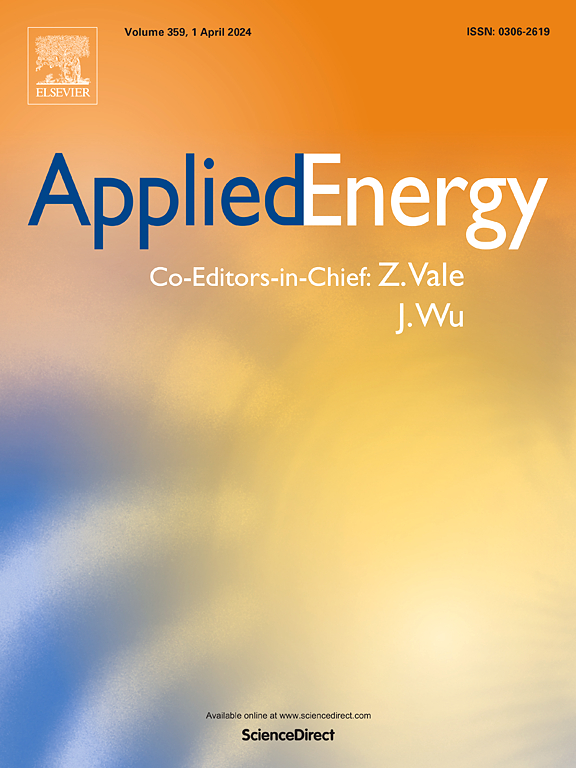Reversing climate policy stereotypes: Evidence from an energy-dependent region and China's major economic circles
IF 10.1
1区 工程技术
Q1 ENERGY & FUELS
引用次数: 0
Abstract
Achieving decarbonization and industrial transformation in typical energy-dependent regions is a crucial step in mitigating regional climate change. This study constructed a factorial carbon policy equilibrium effect model (FCEE) that integrated input–output analysis, a computable general equilibrium model, factorial analysis, multi-regional input–output, and ecological network analysis. This work explored the internal impact of a composite carbon tax policy that considered the endogenous driving forces of the socioeconomic system on Shanxi Province, a typical energy-dependent region in China, as well as the cascading external effects on China's major economic circles. A significant interaction was found between carbon tax policy, production efficiency progress, and emission efficiency progress, confirming advantage of the composite policy in terms of the environmental–economic benefits. In contrast to common stereotypes, the composite climate policy will promote the clean transformation of the energy structure and gross domestic product growth, and water scarcity in Shanxi Province will be alleviated under the energy–water nexus mechanism. Relying on complex cross-regional networks, China's economic inequality will be indirectly eased. The economic driving forces of the Yangtze River, Chengdu-Chongqing economic circles, and Shanxi Province will be strengthened, promoting system stability and sustainability. It is recommended that Shanxi Province implement a moderate carbon tax policy while improving production efficiency; the intensity of emissions technology reform can be flexibly adjusted according to actual needs. This study provides evidence to support the implementation of climate policy, which is of great significance for other similar regions looking to solve the dilemma of sustainable development.

扭转气候政策的刻板印象:来自能源依赖地区和中国主要经济圈的证据
在典型能源依赖型地区实现脱碳和产业转型是减缓区域气候变化的关键步骤。本研究构建了一个集投入产出分析、可计算一般均衡模型、因子分析、多区域投入产出分析和生态网络分析于一体的因子碳政策均衡效应模型(FCEE)。本文探讨了考虑社会经济系统内生动力的复合碳税政策对中国典型能源依赖型省份山西的内在影响,以及对中国主要经济圈的级联外部效应。碳税政策与生产效率进步和排放效率进步之间存在显著的交互作用,证实了复合政策在环境经济效益方面的优势。与普遍的刻板印象不同,复合气候政策将促进能源结构的清洁转型和国内生产总值的增长,并在能源-水联系机制下缓解山西省的水资源短缺。依靠复杂的跨区域网络,中国的经济不平等将间接得到缓解。加强长江、成渝经济圈、山西经济驱动力,促进系统稳定性和可持续性。建议山西省在提高生产效率的同时,实施适度的碳税政策;排放技术改造力度可根据实际需要灵活调整。本研究为气候政策的实施提供了证据支持,对其他类似地区解决可持续发展困境具有重要意义。
本文章由计算机程序翻译,如有差异,请以英文原文为准。
求助全文
约1分钟内获得全文
求助全文
来源期刊

Applied Energy
工程技术-工程:化工
CiteScore
21.20
自引率
10.70%
发文量
1830
审稿时长
41 days
期刊介绍:
Applied Energy serves as a platform for sharing innovations, research, development, and demonstrations in energy conversion, conservation, and sustainable energy systems. The journal covers topics such as optimal energy resource use, environmental pollutant mitigation, and energy process analysis. It welcomes original papers, review articles, technical notes, and letters to the editor. Authors are encouraged to submit manuscripts that bridge the gap between research, development, and implementation. The journal addresses a wide spectrum of topics, including fossil and renewable energy technologies, energy economics, and environmental impacts. Applied Energy also explores modeling and forecasting, conservation strategies, and the social and economic implications of energy policies, including climate change mitigation. It is complemented by the open-access journal Advances in Applied Energy.
 求助内容:
求助内容: 应助结果提醒方式:
应助结果提醒方式:


